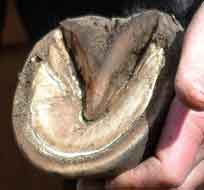Readers have asked to see examples of different hooves, with my comments, so they can learn more about hoof balance and how to deal with various difficulties. I will add photos as I receive interesting ones via email.
They are numbered so you can refer to them when
asking me questions, for example, "My horse's hind feet have a long toe
like the one in Photo Gallery #3."
 |
#1
The right foot (left side of photo) is long on the inside. I would trim about 1/16 inch (~2 mm) along the inside, and then see whether the leg lines up better. Besides the slanted outline of the hoof, another clue is that the tubules (lines in the hoof wall) at the toe are not quite vertical. On the left foot, we can see that the toe (and probably the whole foot) is too long and is flared in the bottom 1/3. |
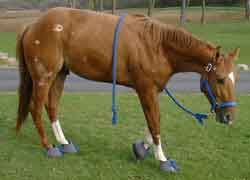 |
#2a
A foundered horse, showing the "founder stance." The back is humped, hind feet well underneath him to take more of his weight, fronts out in front to reduce pressure on the painful toes. (He is wearing Sabre Sneakers.) |
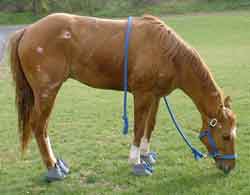 |
#2b
Same horse after removing flares. He is able to put the front feet directly under his weight; the hind feet are closer to a normal position, and the back is only slightly humped. |
 |
| #3
An extremely flared toe, with white line separation starting way up near the coronet. (Put the edge of a sheet of paper alongside the toe wall; the toe should be straight from coronet to the ground.) Right, the same foot after most of the flare has been trimmed off, and the entire hoof shortened. Finished with a mustang roll (rounded edge). At the next trim, the outside of the hoof wall can be rasped to make a completely straight line from the coronet to the toe. The mustang roll can be taken all the way to the inside of the white line (to the edge of the sole) to help the white line recover; when the white line tightens up about 6 months from now, the mustang roll can be ended at its normal position, the water line (white layer of hoof wall). |
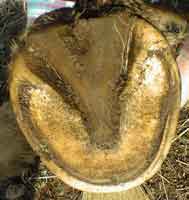 |
#4a
For draft-horse fans. Front foot of a friend's Belgian, several weeks after a nice trim. In these photos you can almost "see" the shape of the coffin bone, which is just underneath the sole. Draft feet have only a slight concavity. This is because the height of the coffin bone doesn't increase in a wider foot, but stays about the same as in the average foot. So the 1/4 to 1/2 inch (7 to 13 mm) of concavity in the sole is spread over a wider surface, and appears flatter.
|
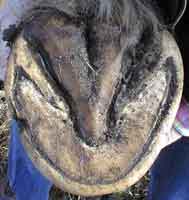 |
#4b
Hind foot of same horse, showing the slightly more pointed shape. There is a quarter crack on the inside, you can see the notch in the wall.
|
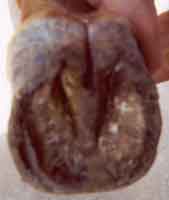 |
#5
This hoof has a long and somewhat contracted heel, which is painful, so that he walks more on the toe and wears it short while the heel tends to grow longer. The incorrect (upright) shape of the hoof capsule makes the side walls flare. On the left side you can see both the flared wall and the separated white line. (Flare and white line separation are the same thing -- the hoof wall has pulled away from the coffin bone.) To tighten up the white line, we would need to shorten the heel and remove the existing flare. First, scrape off the chalky layer of sole, down to hard ("live") sole; then trim the heels down to the edge of the sole. Rasp off the flares on the outside, and mustang roll to the edge of the sole wherever the white line is stretched. This hoof has probably been trimmed for a long heel for many years, and the coffin bone has tried to level itself by growing extra heel underneath. In order not to thin the sole while shortening the heels, we have to keep the heels consistently trimmed down to the sole, to encourage the coffin bone to change back to a more level shape. This may take several years; the heels will be longer than they should be during this time, and the side walls will keep trying to flare. The narrow crease between the bulbs speaks to me of possible fungus infection (see More Topics page). Treating the fungus will allow the frog to widen, which will spread the heels apart and will help the hoof balance overall by reducing heel pain. |
 |
#6
I put this one in to show the pigmented and unpigmented bands of hoof wall. This horse has pigmented hair just above where the coronet is making pigmented wall. Unpigmented hoof is just as tough as pigmented. White feet are not softer : ) |
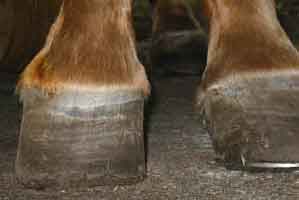 |
#7
Here is a front foot that is long in the outside toe. It makes the whole leg slant out (base-wide). We would expect to find some kind of compensating imbalance in the wear of the diagonal hind foot. |
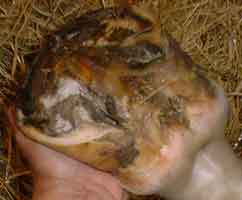 |
#8a
Here is a horse that has been foundered for a long time. This foot shows the typical "block of wood" look: long heels and flat sole, pushed down by the rotated coffin bone. The owner has leveled the heel on one side. There is a lot of chalky sole that can be scraped out in the seat of corn; then the heels can be shortened down to the edge of the hard sole, in a wedge cut that ends about 1/2 inch (12 mm) behind the point-of-frog (see diagram on Founder page). This will rock the weight back onto the heel and reduce the painful pressure of the coffin bone on the sole. |
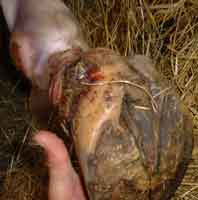 |
#8b
In this foot the coffin bone has rotated so far that it makes the sole bulge outwards; the coffin bone is penetrating the sole just in front of the frog. There is a large abscess that has erupted at the coronet, and the horse had bedsores on many joints from lying down most of the time. The heel is a lot longer on this foot. Again the chalky sole can be scraped out in the seat of corn, and a big wedge of heel removed to get weight off the toe. All the toe wall that is now way out in front of the penetrating coffin bone should be rasped off so that it is not pulling painfully on the white line (see diagram on Founder page). When that is done, the horse will be able to stand and begin walking, and this long-term situation will begin to heal. |
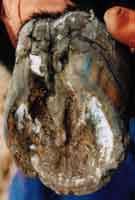 |
#9a
This is an extremely overgrown hoof. The shoe has pulled the heels inwards so that they are underslung and very painful. The base of the hoof is so far forward that I expect the foot was landing toe-first and there would be "navicular" pain also (see More Topics page). |
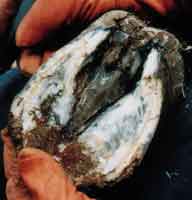 |
#9b
The owner has shortened entire wall and the heel a lot, possibly cutting into the hard sole, which will make the horse sore. The frog is narrow and flaky, with a crease between the bulbs, so I would look for a fungus infection. Treatment will allow the frog to expand and push the heels apart within several months. |
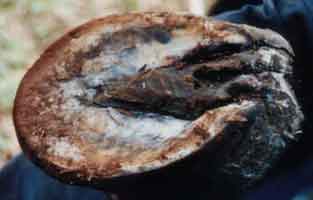 |
#9c
Here we can see that the toe is still long-out-in-front, and needs to be backed. We might remove some excess toe on the outside of the wall. Then, looking carefully at the bottom of the foot, we would mustang roll to the water line along the quarters where the white line is tight, and to the edge of the sole around the toe, where the white line is stretched. |
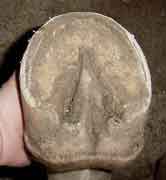 |
#10
A nice foot, showing the mustang roll. It has been rolled past the water line because the white line shows some stretching almost all the way around the hoof (there is dirt in it). The heel on the left side may be a little longer than the right.
|
 |
#11
This foot shows the imbalance with too much toe in front of the widest part, that lands toe-first and develops "navicular" pain (inflammation in the impar ligament). See More Topics page. There is a lot of flare and white line stretching, especially in front of the line. This should be backed heavily and mustang rolled to the edge of the sole, until the white line tightens up in 6 to 12 months. It looks like the heel has already been shortened to a good length. |
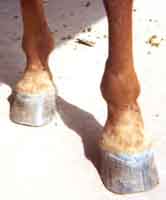 |
#12
Here are two feet that are probably worn just about right across the toe, but there are "corners" in the outline of the hoof base which are making it hard for the horse to stand squared-up. The corners will tend to flare and stretch out the white line. The outline should be rounded to a nice even curve, matching the curve of the coronet when you look from directly above (your head by the horse's shoulder). On the closer foot, I would also look for the inside to be slightly long; the tubules (lines in the wall) don't look exactly vertical. You can see it better if you get your eye down at ground level -- looking at horse feet is not a standing-up activity : ) |
 |
#13a
This foot is a little long all over,and has flared out at the heel to make a quarter crack (different from the usual underslung quarter crack). |
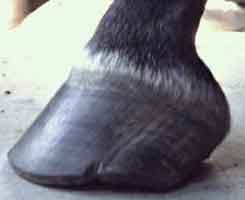 |
#13b
Side view, showing the crack better. |
 |
#13c
Here we see what is going on. The entire wall is too long and needs to be trimmed back to the level of the sole. The quarters are starting to crack out. This is how a horse self-trims in the wild. Eventually the entire wall will trim itself back to sole level, given a 20-miles-a-day (30 km) lifestyle. |
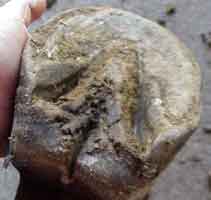 |
#14
This foot looks like the heels are too long, and they may be; we could try scraping chalk off the sole in the seat of corn. On the other hand, the frog looks fungus-y (flaky layers and a deep crease between the heels-- see More Topics page). Treating the fungus would allow the frog to grow up to the level of the heels. |
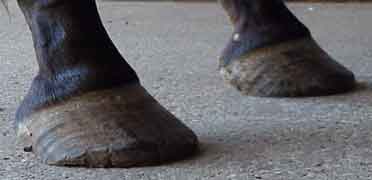 |
#15a
These front feet are a little long overall, and there is some toe flare. |
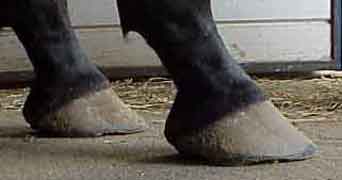 |
#15b
The hind feet. The length looks about right. You could make the wall a little straighter, probably around the entire toe. I would like to see more mustang roll around the toes. |
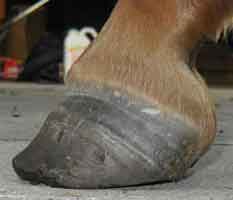 |
#15a
This one looks long overall, the heels look contracted, and there is a little flare at the toe where it's trying to self-trim. The deep crease partway down tells that it may have slightly foundered about 3 months ago; or it may indicate when the shoes were removed. |
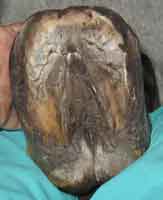 |
#15b
Underneath, we can see the too-long wall on either side of the toe. The frog looks fungus-y; it's narrow and has a very tight crease between the bulbs. Treating the fungus will allow the frog to grow wide, pushing the heels apart, and the entire hoof will be wider and better-balanced. In most of the hoof capsule (see 15a), the white line is tight, so we see plenty of concavity.
|
 |
#15c
The owner's first trim. In shortening the wall, I would have stopped at the edge of the sole; here the sole has been thinned all the way around, and the horse was probably sore for a while. The toe looks much better and there is a good mustang roll. Hard to see in this photo, but I'd make sure the wall is not touching the ground along the quarters where the white line is stretched (looks dirty). |
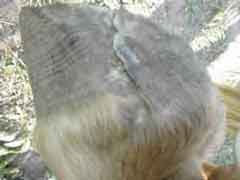 |
#17
A hoof with a wall crack due to an old injury. Since the injury is in the coronet, the crack will always be there. We do the best we can with injured hooves, knowing that they also do the best they can to grow into a useful hoof-shape. The quarters look too long, I would like to see a straight line for the hoof base, rather than a convex curve. The owner has rasped off the edge of the crack so it won't catch on things. Overall, it looks like a good hoof. |
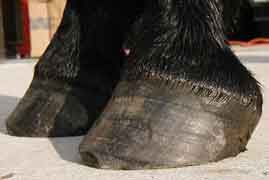 |
#18a
Nice hooves. The heels look long. This is a good example of "backing the toe," the vertical cut around the toe. You could also do a more rounded "mustang roll." |
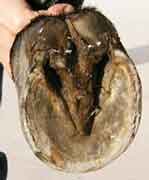 |
#18b
Underneath, we see that the heels are trimmed almost to the level of the sole. They could be shortened another 1/8 inch (3mm). This looks like a hoof that has had long heels for many years, like #5, so that the heels of the coffin bone have tried to grow lower to make the bottom level. Therefore, the heels will have to be shortened gradually over several years; otherwise you will thin the sole in the seat-of-corn, and the horse will be sore in the heels.. In the meantime, the frog is wide and healthy, and the sole is nicely concave, so I would expect this horse to go sound just as it is. |
 |
#19a
About 3 months after a founder. You can see the new growth at the top. Just above the founder line across the front, there are several creases that formed as the wall was growing, from the pressure of the slippered toe upwards against the coronet. Below the "founder line," the white line is stretched, and the old hoof wall is not well connected to the coffin bone. The toe has been backed well into the stretched white line. The thick, "punky" white line is clearly visible as a gray area across the bottom. |
 |
#19b
Bottom of another foot on the same horse, showing where the toe of the coffin bone is penetrating the sole (reddish area). This foot can be made more comfortable by shortening the heels (see diagram on Founder page) to take the weight off the toe; and by removing toe flare around the entire toe. |
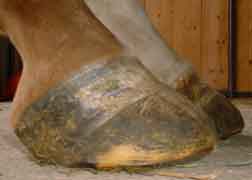 |
#19c
Hind feet of the same horse. Again you can see the new, healthy growth in the top part of the hoof wall; the founder line; and the "old foot" at the bottom. It's OK to leave the bulge for protection, though you could also rasp it off to make a straight surface all the way from the coronet to the ground. The heel height looks about right. I would probably back the toe a little more, or carry the mustang roll a little farther underneath the hoof. |
 |
#20a
This pony lives outdoors in New Brunswick, Canada. Excellent hind feet with beautiful concavity. Before trim: at the heels and quarters, the wall is longer than the sole, especially on the left side of the picture. |
 |
#20b
After trim; the heels are still longer than the frog, which can be used as a guideline because it is full and healthy. It looks like the heels could be shortened a little more without cutting into the sole. |
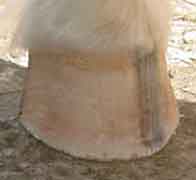 |
#20c
Shows the cone shape of a healthy hoof wall -- wider at the bottom than at the coronet. |
 |
#20d
Looking from above, shows the slightly pointed shape of the hind foot; this gives more traction than the rounder shape of a front foot. |
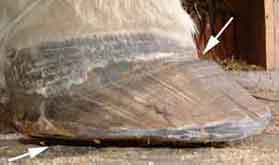 |
#21a
Here is a draft horse's foot about 2 months after a founder. Upper arrow marks the founder line. Above the arrow, the new wall growth is attached to the coffin bone; below, the old wall has pulled away from the bone and is dramatically flared. Lower arrow: this horse has massive frogs. The owner trimmed the wall to the edge of the sole and left the frog slightly longer; she had trimmed the frog before and it grew back quickly. I told her this is OK, it will give the horse something to walk on comfortably while the foot heals. |
 |
#21b
We can see the "old foot," as well as the "new foot" that will grow around the present position of the coffin bone. If we follow the angle of new wall growth (line), this shows how much flare can be removed. We might remove the flare gradually, using a vertical cut, leaving
some of the upper wall to protect the bone from bumping into things. However,
the mustang roll should reach as far as the line and a little farther.
See sole view, below.
|
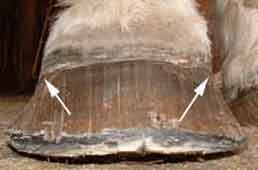 |
#21c
Looking from the front, the side walls have also lost their white line connection with the coffin bone. Arrows point to the founder line; the wall below the arrows is flared and needs to be removed. |
 |
#21d
Lines show how much flare should be removed. Again, we could use a vertical cut, leaving some of the upper wall for protection. The mustang roll should round in a little, inside the lines. |
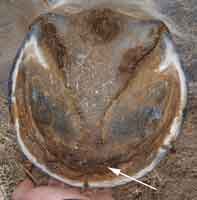 |
|
 |
#21f
The flare should be removed to the edge of the sole, about where I have drawn a (wobbly) line. When the flare is backed up to this line, the horse will immediately be more comfortable and will walk around without being forced. Increased circulation will help the hoof wall to grow faster. |
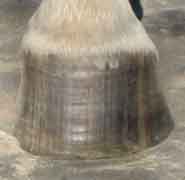 |
#22a
A left front foot with upright wall on the inside quarter, and a sloped wall on the outside quarter. The front tubules (lines of hoof wall material) are vertical. |
 |
#22b
Sighting across the bottom of the foot. Although the base is nice and flat, the hoof leans to the outside (right side of photo). Question: is the slanted wall longer than the upright wall, or is it a flare? Should we shorten the leaned-out side, or remove flare? |
 |
#22c
The sole view gives an answer. There is white line separation along the more sloped side of the foot. We will try rasping away the outside surface of the wall along the outside quarter, well into the white line so the wall is not in contact with the ground. Renew as the wall grows down, until there is no remaining white line separation. |
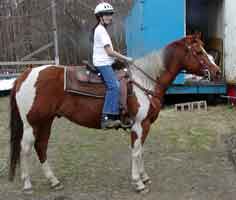 |
#23
The owner sent four photos of this horse. In every photo, the front feet were squared-up, showing that they are balanced in their trim and not painful. In all four photos, the right hind was back and the left hind forward. This is a strong clue that there is some imbalance in one or both hind feet. It looks like the right hind is too short in the toe, so that he has to put it behind to have his joints comfortable. We would work on growing some toe. I would also look carefully at the left hind to see why he is not bearing weight on it fully. |
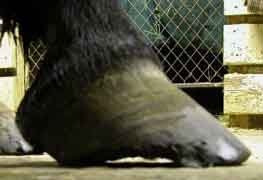 |
#24a
The shoes were recently pulled off this horse, about 8 weeks after the last shoeing. He has already broken out the quarters -- this is how a hoof starts to self-trim when it is too long. We will shorten the heel a bit and the toe more (underneath), and back the toe into the white line because there is some flaring in the toe. |
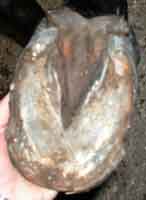 |
#24b
Showing how the wall has grown much longer than the sole. It is also starting to break out at the quarters. On the bottom, we will shorten the wall down to the level of the sole -- like cutting a glass down to the level of the water. Then mustang roll all the way to the inside of the white line (e.g. the edge of the sole) until the white line is no longer separated; I would guess 6 to 8 months on these feet. |
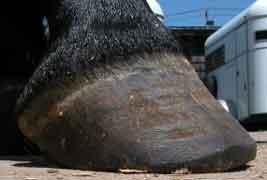 |
#24c
The same foot after two trims. The owner used a vertical cut to back the toe because she is figuring out where the white line is; next time she can round in the mustang roll. |
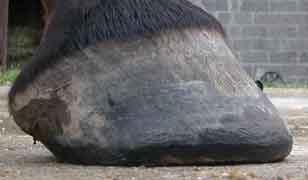 |
#24d
About 4 months later, the hoof is shaping up well. There is still some toe flare; the owner has rasped most of it off. Good example of a mustang roll. |
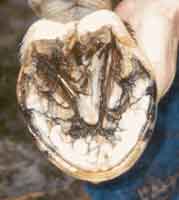 |
#25a
The hind feet of a horse just out of shoes. Both soles have a lot of chalky, crackly, exfoliating sole; when it is removed we will be able to see the surface of the sole and can use it as a guide to, probably, shorten the heels somewhat. On this foot, it's obvious the crackled sole should be scraped away. |
 |
#25b
Here, it is not so obvious that the sole has a chalky layer over it. Look at the "cliff" of excess sole around the front half of the frog. The owner said this foot was sore. I see two possible reasons for discomfort: the long heels, and the excess sole which probably bruises the sole corium.
|
 |
#26a
There is evidence of trauma at the arrow, such as a brief founder episode or a major change in feed. Or it could show that the shoes were pulled, and the white line is better connected in the new growth as it comes out of the coronet. Underneath, the wall is already trimmed down to the sole, so the way we work on the long-toe-in-front is to be back it to the line. |
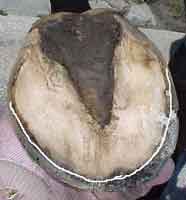 |
#26b
Sole of #26a. In fact there is white line stretching, which agrees with the possible brief founder episode. The toe needs to be backed to the junction of white line and sole (curved line), and looking at the large amount of toe in front of the widest part, probably more in the next few trims as the hoof gradually re-shapes itself. |
 |
#26c
Heel view of the other front foot, showing one wall "inside the vertical" (arrow). The other side is much longer, causing the hoof to lean over. When we trim the long heel and that whole side to a new level position, the pushed-under wall will be able to widen if the horse gets enough daily movement on a firm surface. This foot also needs the toe backed, similar to #26a & b, which will help the heel to expand and the walls to slope out wider. |
 |
#26d
Both front feet are toed-out. We can shorten the outside toe underneath (at the arrows) until the horse stands with the toes pointed directly forward. When it's right, suddenly the front legs look like "small trees planted in the ground;" that is, the weight of the legs comes straight down through the center of the hoof. It looks like the hind feet are also long at the outside toe. I've seen several horses with all four feet toed-out; my hunch is that the hinds wear like this as a compensation for the toed-out fronts. |
